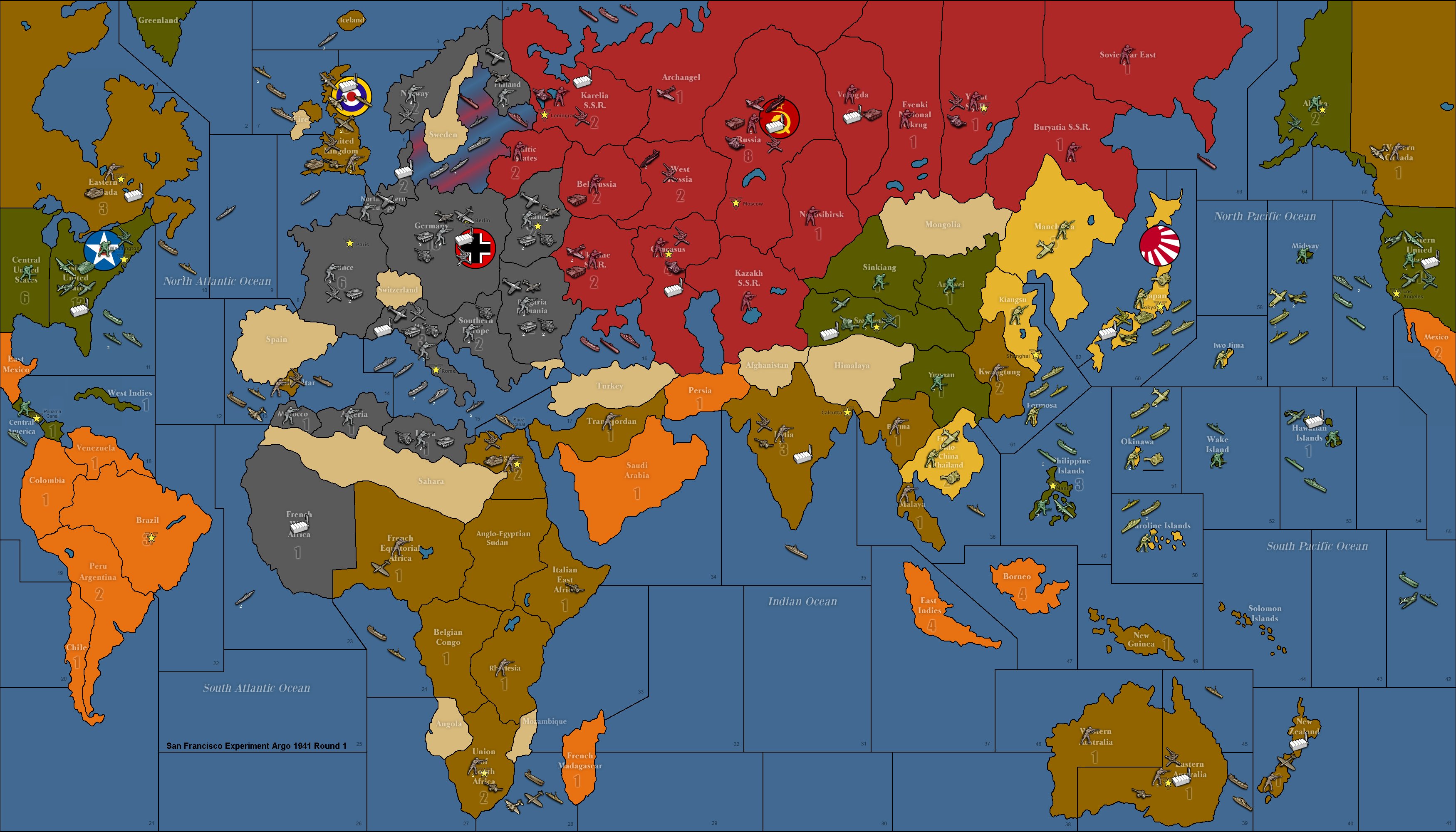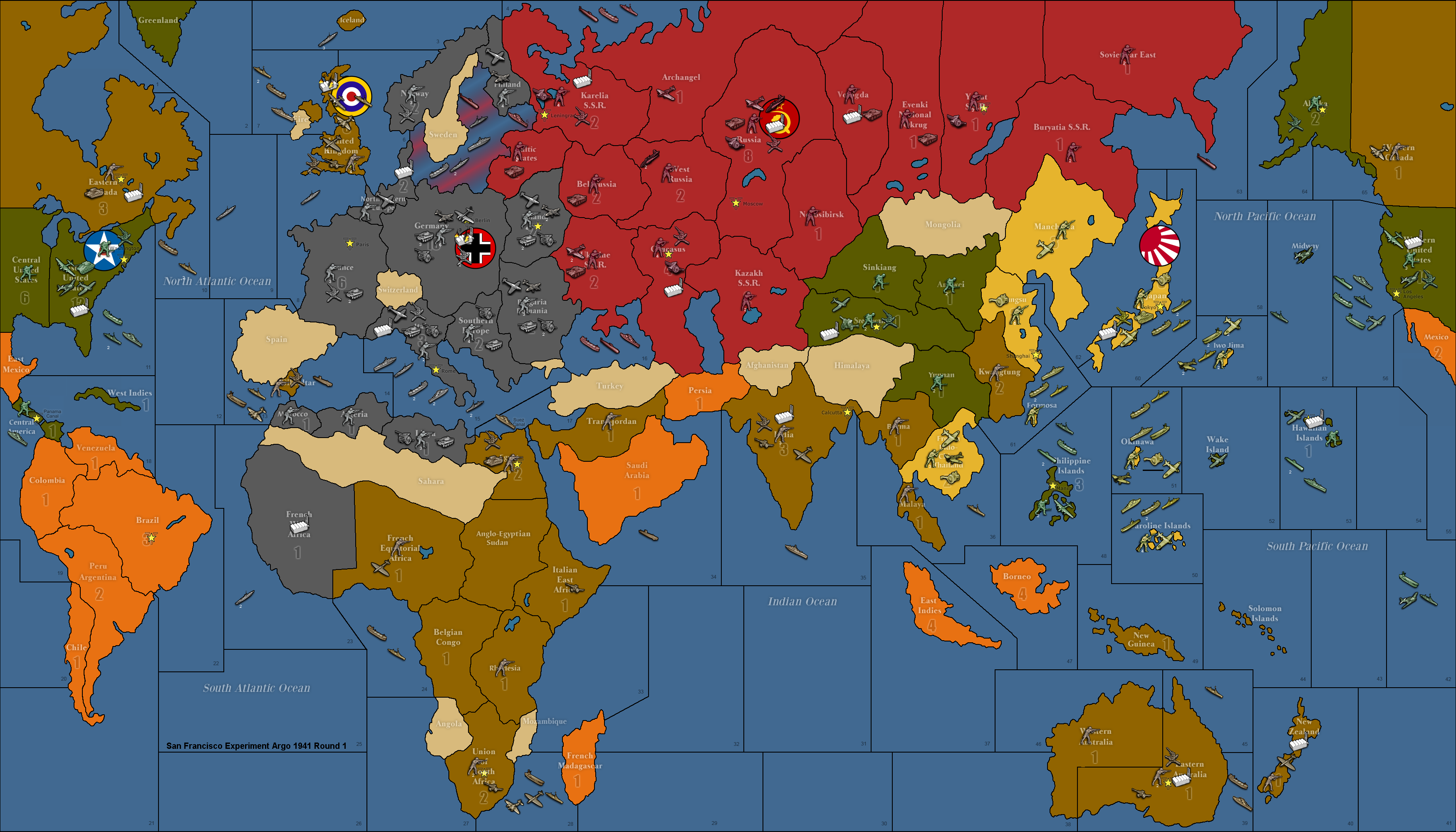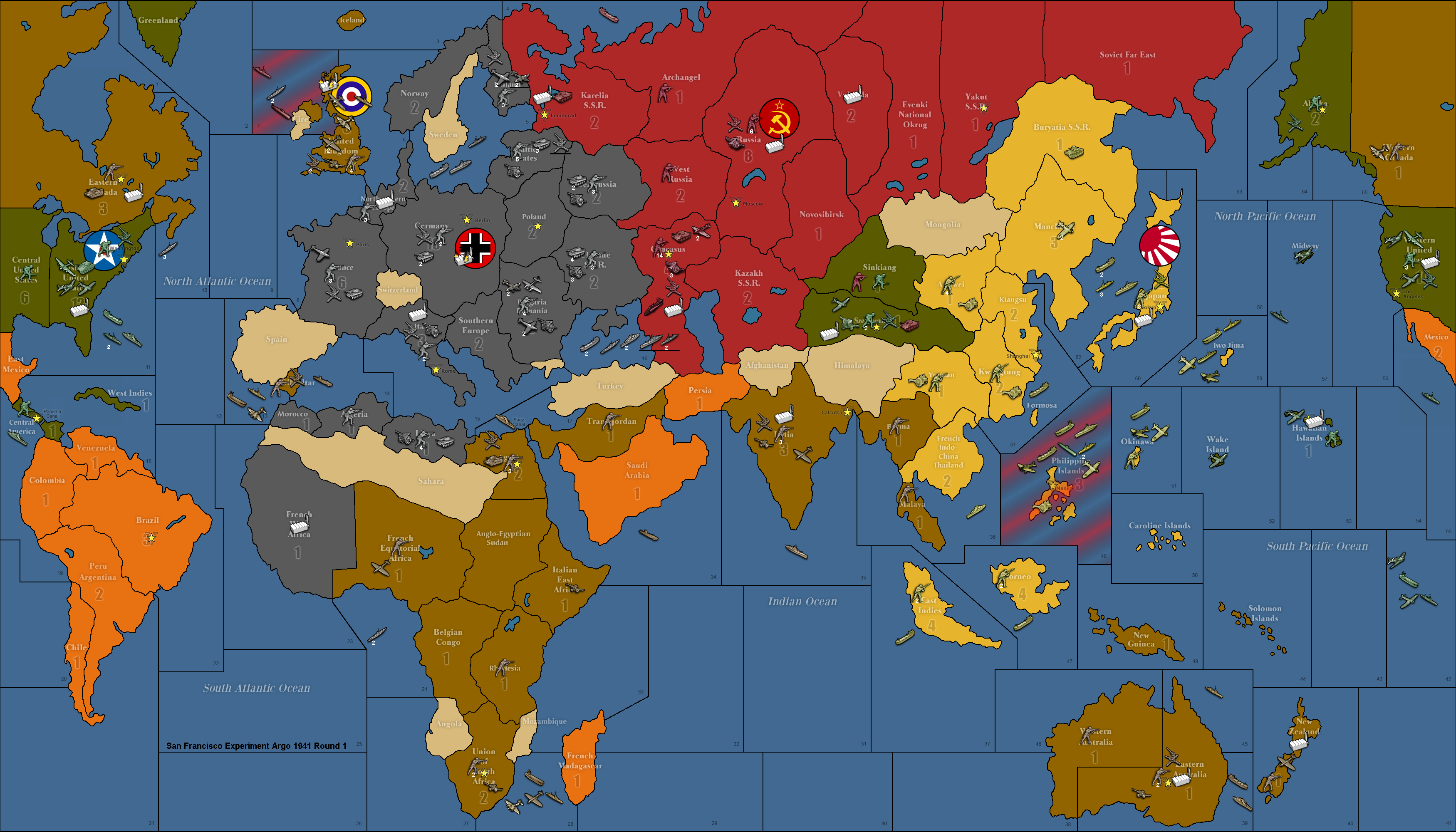@Argothair:
I think it works! I think we’re done here, at least as far as an Alpha version to send out to the wider community. I can’t think of any changes that I feel confident would improve this setup. :-)
I tested a G3 Sea Lion, and it does not seem to work unless Britain is caught totally by surprise. The problem with leaving the Russian air force alive to conserve the German air force is that the Russians can just fly their planes over to London for extra defense. Also, if Britain sees the Sea Lion coming, then they can keep their African fleets on the west coast of Africa, and then a combined assault on UK2 + US2 can probably destroy the Axis Mediterranean fleet, which means two fewer transports that are available to hit London. Still, if everything goes perfectly, a Sea Lion could work. Japan has to keep the USA busy enough that it can’t afford to send any fighter reinforcements to London. The Sea Lion chances were 0% for Germany in my test, but if you remove 1 Russian fighter and 3 American fighters, then I think it switches to something like 20%.
I would prefer higher odds for a G3 Sea Lion, but I’m not sure how to make that happen without disturbing other aspects of the game.
I also tested an immediate G1 Barbarossa blitz, with Germany building mostly tanks and sending both Med transports to take the Caucasus on G1, plus using the Finnish troops to take Karelia G1. I was not able to take Karelia, but it did weaken Karelia enough that all of my eastern front forces were safe. UK & USA were able to save Moscow by steadily flying in fighters and sending reinforcements from India/Egypt, but this means that Japan would have become a monster (I did not actually use Japan’s turns for these two tests). I think a G1 blitz is much weaker than a more reasonable German opener that only attacks Baltic/Belorussia/Ukraine with land forces, and waits until G2 to attack Leningrad and Stalingrad – the optimal G1 move is probably to send one Med transport to Ukraine (so you don’t run out of infantry there to soak hits) and one Med transport to Egypt (for the TUV profit, and so those forces don’t wind up coming to the aid of Stalingrad a couple turns later). Still, the G1 blitz is an interesting alternative to have on the table, and depending on how Japan exploits the Allies’ distractions, it could be a viable opening!
I also tested some battles in the Pacific, and it seems to see-saw for quite a while, with Japan and the USA each able to destroy each other’s fleets at a profit, turn after turn. That’s pretty cool! It’s not obvious that either or both players would actually want to throw 60%+ of their budget into continuing to smash up fleets near Hawaii, but it’s good that that’s an option. The factories in Hawaii and Sydney go a long way toward making the South Pacific something worth fighting over; it really does seem to matter when you win control of a sea space. If America is off the coast of Hawaii and can hold it, that means a big boost in USA’s Pacific momentum because they can build a carrier in Pearl Harbor and fly in planes to land on it from the mainland. On the other hand, if Japan can deadzone the coast of San Francisco (not at all unlikely, if the battles go well for Japan and the USA tries to split its attention between both theaters!) then it can be a real challenge for the USA to make a Pacific comeback – even if they have ships near Hawaii or Mexico or whatever, those ships may be effectively dead for lack of an ability to reach reinforcements/safety. The M3 transports threaten San Francisco once the USA loses control of its sea zone, the submerging unblockable subs provide some additional fodder in regions that would otherwise be deadzoned, and the M3 cruisers and carriers equipped with 3.5 attack fighter/tacB pairs really help project offensive power three spaces forward instead of just two spaces forward. It’s all very exciting. I can’t be sure that it’s balanced, because there are hundreds of plausible combinations for Japan’s five fleets vs. USA’s three fleets, but that’s a good thing! There are options. :-)
Anyway, great work on this map. I vote we slap both of our names on it, submit it to the tripleA experimental map collection, and call it a success.
Thanks Argo,
I checked your partial game. Seems fine.
I think it is interesting to left alive 1 or 2 Soviet planes.
I’m actually trying this setup myself since you seems to agree with the few points I added in.
Moving VTs from Eastern Canada to Iceland and Poland to Ploesti in Romania need to be done, one day or another.
I’m not convinced about Rio over Carolines Islands, need to see deeper mid-game and how it impact balance.
I did not try a +1 $ single bonus at the end of a turn per VT owns and a +1$ to split between Alliance members. This will be next once the general rough balancing and depicting history will be done.
The old Capital capture is dominating my play-tests.
Your Japanese fleet groups allow for a lot of openings. I like to feel there is too much things to do and not enough units to get the job done.
IDK for sure about West Coast fleet vs Midway fleet.
I’m still able to obliterate everything. And US1 counter-attack is not very punchy when all three full Carriers and a Battleship are all at Midway.
1 IJN Destroyer is needed in Midway against Soviet Sub but it allows to throw it in against West Coast fleet.
At least, it reliefs UK fleet from an important power projection when all IJN Carriers are at Midway.
The need to control both Norway and North-Western Europe seems very hard on Germany.
I’m not sure about that one. It is blocking a lot of possibility for German Baltic Fleet.
Maybe only NWE need to be controlled?
Here is a saved game of 3 rounds, it is G4, but not played.
I totally missed a Sea Lion. The start was awful, I lost too many Subs.
Also, I lacked coordination with Med Fleet.
Japan was dominant at Midway but loose the edge against UK in South-East Asia.
Also, Submarines can be a real pain if there is no air cover to protect warships and TPs.
I lost 1 BB, 1 DD and 2 TPs to a Soviet Sub. And 1 Cruiser, 1 DD, 1 TP to 1 US Sub.
I’m not so sure that Sub should not be block at all…
But, I would like a rule when crossing a SZ in which there is Destroyer…
Probably a good thing to implement. Each DD can roll 1@1 ASDef.
I forgot to apply this rule. And I feel very much OK.
If you choose to move any type of surface ships through a sea zone containing one or more enemy submarines without stopping to fight those submarines, you must roll one die per enemy submarine (it does not matter how many ships you move, only how many enemy subs there are).
Your fleet takes one hit for each “1” rolled on the dice.
If you move through more than one sub-infested sea zone, repeat this process.
But, it can be the other way around. Each DD roll once regardless of Sub number.
I believe Germany needs a bit more Infantry or Tank at start to make Sea Lion more plausible.
After a second opening try, I still feel it needs a bit more Infantry to fight on Eastern Front.
It was pretty much interesting to lose 4 planes and Russia kept its 2 TcBs. AAA rolls snake eyes.
I made a V3: Germany, Poland and Romania received +1 Infantry.
NWE received 1 Armor.
Norway, moved 1 Infantry into Finland to reach 4 Infantry.
IMO, the temptation to use planes to boost a Karelia G1 with 4 Infantry (vs 4 Inf and 1 Art) might rise the dilemma toward not launching plane on UK’s fleet and lets Subs doing the job, partially at least.
Extreme StBs purchase and Subs should probably be tested to be sure it is not OP.
1941Argo_edit setupv2_TcBsRussia4G.tsvg
1941Argo_edit setupv3_TcBsRussiaG1.tsvg








